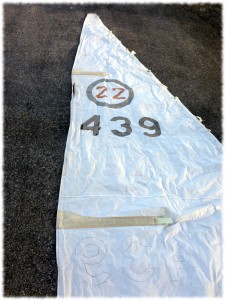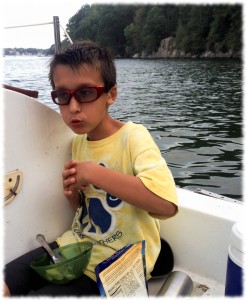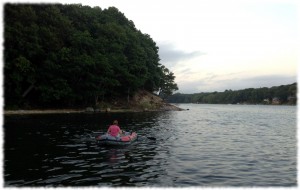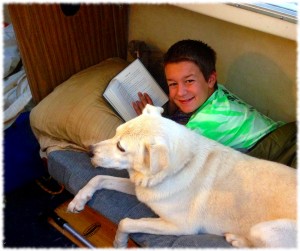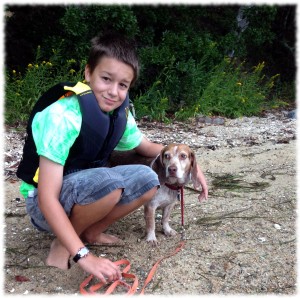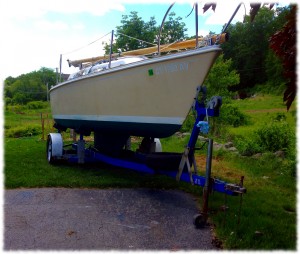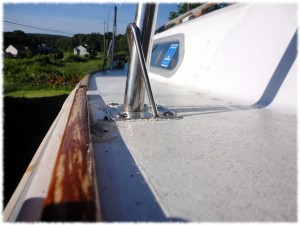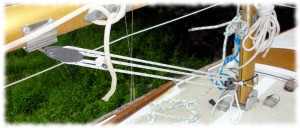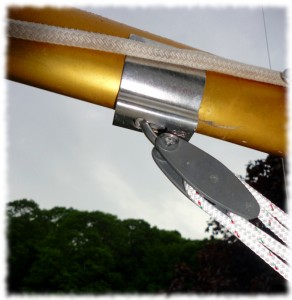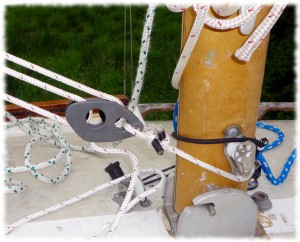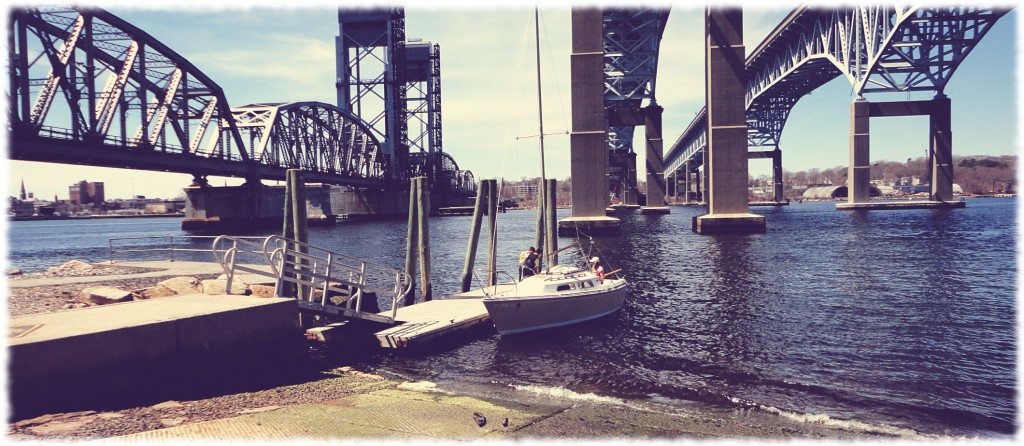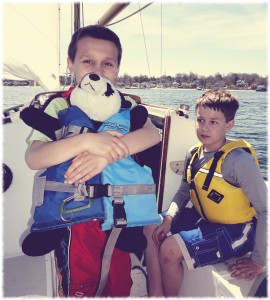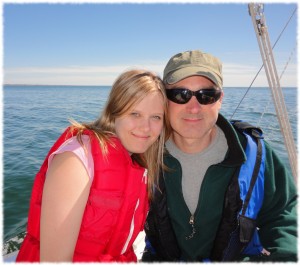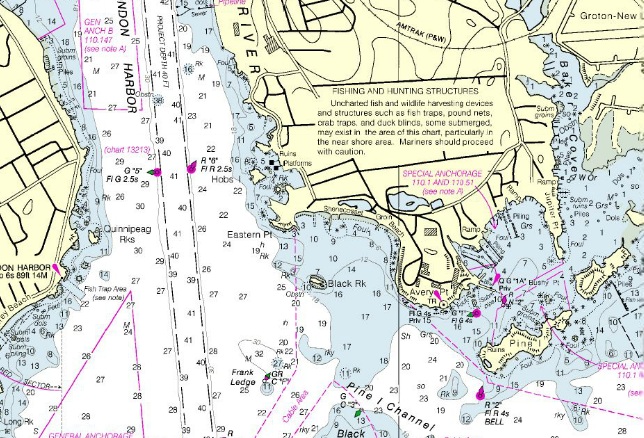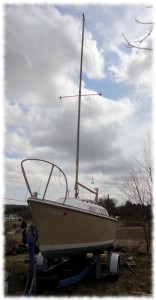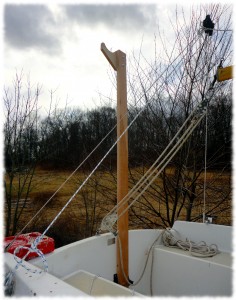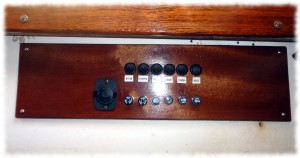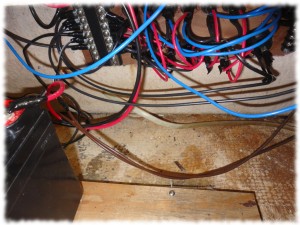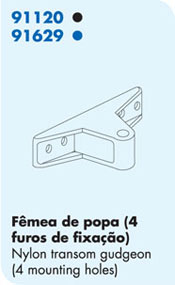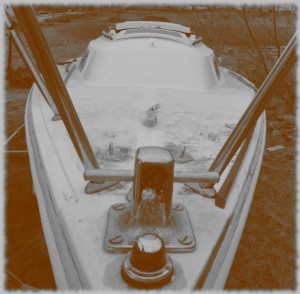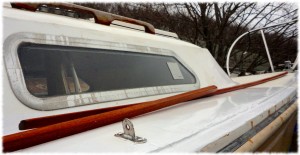After reading my post about my experiences buying a cruising sail for the O’day 22 online, Judy Blumhorst of Hyde Sails Direct offered to provide her perspective on purchasing cruising sails online. I think that it is a good summary of what I found through my searches online for information when I was researching new sails.
How to Buy Cruising Sails Online
Understanding the basics
of Sail Design, sail cloth & construction
By Judy Blumhorst, June 2015
One of the biggest expenditures a recreational or cruising sailor ever faces is replacing their sails. As the owner of an online loft (www.HydeSailsDirect.com), I know that cost and longevity are the biggest concerns of most customers buying new sails.
The cheapest sails, however, aren’t always the best value over the long-term. They don’t hold their shape for very long and will need to be replaced much sooner.
Understanding the basics of sail design, sail construction and sail cloth engineering will help you get the most bang for your sail-budget buck, and keep the wool from being pulled over your eyes by unscrupulous online lofts.
Q: When do I need new sails?
A: When your sails were new, your sailmaker designed an ideal shape for your boat and your rig, the type of sailing you enjoy, and your local conditions. Over time your sail cloth deteriorated, and the sail lost the shape your sailmaker intended it to have. The loss of shape makes your boat harder to sail and reduces your sailing enjoyment. When your boat won’t point as well as it used to, heels more than it used to and is harder to control, it’s time for new sails.
Even though your sails may not have any tears or rips, you will enjoy sailing much more if you replace your sails when the original shape is lost.
Q: Why is good sail shape important?
A: Obviously good sail shape is important for racing, but increasingly cruisers are realizing the benefits of good shape. Good sail shape translates into less heeling, better pointing, easier boat handling, and the ability to handle higher winds comfortably.
Q: What difference does the sailcloth make to me?
A: High quality, name brand sailcloth has low stretch, holds its shape for a long time, and is durable so it has a long, useful service life. Sails that are made from low quality Dacron last a long time without ripping, but they lose their shape quickly.
Q: Woven Dacron or Laminate? What is the Difference?
A: Since the 1950’s, woven polyester (Dacron) has been the most popular material for cruising sails. Over time, boats grew larger and cruisers demanded better performance from their cruising boats. Sailmakers and cloth manufacturers needed improved fabrics that could resist higher loads and retain their shape better.
In the 1960’s and 1970, laminate sailcloths were invented to fill the need for better shape-holding. The early laminates were plagued by durability problems, and didn’t last very long. Laminates and Woven sailcloth have come a long way since then. Today, modern laminated sailcloth is more durable than the old laminates.
Laminates are made by gluing layers of different materials together to form a sandwich. Basic laminates consist of two layers of plastic film sandwiched around load-bearing yarns. The fibers are carbon, Spectra/Dyneema, Twaron, Technora, Kevlar, Pentax and polyester. For cruising laminates, an additional layer of polyester is laminated on the outside to improve the fabric’s resistance to UV, tears and abrasion. Generally speaking of durability, most sailmakers assume that three to five years of frequent use is a reasonable lifespan for laminated cruising sails. With less frequent use, cruising laminates will last longer.
Today, highly advanced woven Dacrons can carry much greater loads with less stretching. The most advanced Dacron sails hold their shape as well as cruising laminates and last longer.
In the past 10 or 15 years, Challenge Sailcloth developed a Dacron named Warp Drive for use in radial-panel sails that holds its shape as well as most cruising laminates. Contender Sailcloth and Dimension Polyant Sailcloth invented high-tech ways to blend polyester, Vectran, and Spectra/Dymeema yarns together into hybrid woven Dacron. (Challenge Sailcloth makes Hood Vekton , Contender Sailcloth offers “Hybrid Fibercon” and Dimension Polyant offers “HydraNet Radial”).
Q: Why are the new radial woven fabrics so important for cruisers?
A: Woven Tri-Radial cloths are a big deal because they let sailmakers design and build tri-radial sails in woven cloth. Dacron is still the most durable fabric in absolute terms. Tri-radial construction deforms less under loads. Tri-Radial sails of Dacron have excellent shape retention and excellent durability. That’s a powerful combination for long-term performance and long-term affordability – a lot of “bang for the buck” for cruisers.
Sailmakers orient the panels to resist all the loads better and retain shape over time better, compared to cross-cut sails. Dacron Tri-radial sails offer owners excellent durability for long service life as well as excellent shape life, at a price that would have been inconceivably low in past years.
One important point to remember if you are buying a new sail is that the cloth used for a tri-radial sail and the sailcloth used in a crosscut sail are not interchangeable. Modern woven cloth for tri-radial construction is considerably more expensive than sailcloth for cross-cut sails. Name brands are Challenge Warp Drive ($$), Contender Hybrid with dyneema ($$$) and HydraNet Radial with dyneema ($$$$).
Q: Who manufactures the best Woven Sailcloth?
A: In the United States and abroad, four major suppliers of sailcloth—Dimension Polyant, Bainbridge International, Challenge Sailcloth, and Contender Sailcloth—provide sailmakers with Dacron, Dacron blends, and laminate cloths and related materials to build strong, state-of-the-art headsails and mainsails.
Q: WHY ARE THERE SO many different Dacrons?
A: There are many reasons for the multitude of cloth styles and prices.
Sailcloth manufacturers build cloths to meet a wide range of price points, from budget to premium.
Sailcloth engineers design dozens of different types of cloth so the sailmaker can choose the best cloth that will have the best shape under load.
Q Why do some Dacrons cost much more than another? Aren’t they all the same.
A: The more expensive Dacrons generally stretch less. They cost more because the raw materials cost more, the technology is more complicated, and they take longer to weave. Also, cloth manufacturers can demand a higher price because low stretch Dacron makes a better sail.
However, economies of scale during production greatly affect the price of sail cloth. Popular cloths which are produced in greater quantities cost less.
Also, production lofts that buy in massive quantities get lower prices from the manufacturer, and save on transportation costs too.
Q I’m a Cruiser, not a racer. What is the best value in sails for Cruisers?
A: As a sailmaker, customers frequently tell me that they want to buy the least expensive sails I sell because “I’m not a racer. I don’t need fancy sails”. I think that’s the wrong perspective to have when you’re buying sails. The less expensive sails don’t retain their shape as long as better quality ones. You will have to replace the sails sooner because your boat sails poorly sooner
Here’s a better way to look at it: In general, you should buy sails made of the lowest stretch cloth you can afford. The only time this doesn’t apply is when you are going to sell the boat within one or two seasons. All things being equal, the less expensive fabrics don’t hold their shape as long as the more expensive ones. When your sails have lost their designed shape, it’s time to replace it — even if it hasn’t ripped.
Q: I’m on a budget. What cruising sails should I buy if I can’t afford the “best Dacron”?
A: The answer is the same as before: Buy the lowest stretch Dacron that you can afford! It will give you several years of good service. But in the long term, you will need to replace them sooner than the less expensive Dacron.
Q What should I tell my sailmaker when I’m buying new sails?
A: I’m sorry, but that’s a trick question! You can tell your sailmaker whatever you like, but it’s the sailmaker’s responsibility, not yours, to get all the important information necessary to select the right sail for your needs. At the least, the sailmaker should interview you to find out the following important needs:
- Your sailing experience and level of skill
- Your expectations about performance
- Your expectation about durability
- Your expectations about ease of use (Are you willing to “baby” the sail or are you more casual about how you treat your sails?)
- Your time horizon for using the sails
- Your sailing style (eg race vs cruise, set-and-forget cruiser vs string-pulling-trimming cruiser)
- Budget
- Miles/hours sailed per year,
- Climate (humidity, UV)
- Wind range and sea state on your cruising grounds.
Q: How do I avoid “getting the wool pulled over my eyes”
Unfortunately, there are a scam artists on the internet who sell inferior products, misrepresent the goods or use counterfeit imitations of name brand cloth. I have personally examined sails that were made of a less expensive, inferior Dacron sail cloth than promised. Those owners told me their horror stories when they hired me to be their sailmaker after being ripped off by a dishonest online loft.
It’s particularly easy to scam people buying new sails because the average sailor can’t tell the difference between cheap sailcloth and expensive sailcloth once the sail has been delivered. The crook substitutes cheap cloth for expensive cloth and pockets the difference. The substitution isn’t obvious for a year or longer, when the shape of the sail deteriorates rapidly. By then, it’s too late for the buyer to do much about it.
Ultimately, the most important factor in choosing your sailmaker is their reputation. Make sure you carefully check the reputation when you hire an online loft.
- Do some research online about the firm. Check the Better Business Bureau and Google. There are very few complaints online about honest and competent sailmakers.
- If you discover numerous complaints about quality or service during your online research, don’t buy from that business. As the saying goes “Where there’s smoke, there’s usually fire”.
- Do some comparison shopping, but don’t be seduced by super low prices. There are several well established online sailmaker lofts with good reputations on Google. If a small non-name brand loft claims to be able to sell the same sail for 30% less than the other online lofts, exercise extreme caution. If the price at one online loft “is too good to be true” be very, very cautious. Don’t let the promise of a low price cloud your judgement.
- Get the name of the person advising you on cloth selection online and check his sailing resume online.
- Get the name of the person designing your sail and check his sailing resume online.
- Get the name and physical address of the loft building your sails. Honest lofts don’t hide where their sails are built.
CAUTION IF YOU ARE BUYING SAILS ONLINE: The cost of the cloth is the biggest factor in the price. Protect yourself against a “bait and switch” on the cloth. Insist that the invoice shows the brand name and manufacturer’s style number of the cloth in writing. A weight designation is not a style or part number. Don’t accept vague descriptions that don’t include the style or part number!
Understanding loads on Sailsi
Challenge makes two versions of many of its super-premium & premium woven dacrons: High Aspect and Low Aspect. They engineer different constructions to align the strength of the fibers with the load direction of the sail. One is not better than the other. They are both engineered for a specific application.
Loads on High Aspect Sails

A high aspect sail is tall and narrow. By definition, the luff is at least 2.9 times as long the foot.
It generates the most load along the leech. A High Aspect cloth generally has larger fill yarns and is very strong in the fill direction. The warp yarns almost touch each other in the weave, creating tunnels in the construction which keeps the fill yarns geometrically straight and low stretch.
Loads on Low Aspect sails

A Low Aspect Sail is short and wide. By definition, the luff is less than 2.9 times the length of the foot. The loading directions are not parallel, and run more toward the center of the sail.
Low Aspect cloths generally have larger warp yarns than in a high aspect fabric, and while the fill yarn is bigger than the warp yarn, they are closer to equal size than in a High Aspect Cloth.
There is more even crimp between the two fibers. The even crimp allows the yarns to grab each other, thus creating a strong resistance to bias stretch.
Understanding How Panels for Sails Are Cut
Aligning loads with Low-Stretch Yarns
CrossCut Sails
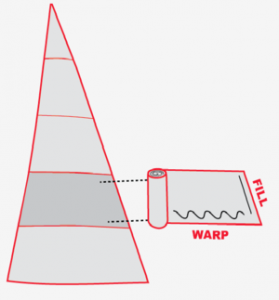
Crosscut sails have long panels that go horizontally across the sail, perpendicular to the leech and the heaviest loads on the sail. The yarns that go the length of the cloth are called fill yarns. The warp yarns, which cross at 90 degrees, are woven over and under the straight fill yarns. The technical term for bending the yarn is called “crimping”.
For crosscut sail panels, yarns in the fill direction have minimal stretch because they are relatively straight. The yarns in the warp direction are comparatively stretchy because they are crimped.
Tri-Radial Sails
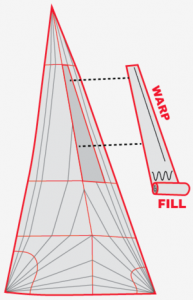
Tri-Radial sail panels align the straight warp yarn with the load direction. The panels must be cut parallel to the length, not width, of the sailcloth
The best Dacron cloths for Tri-Radial sails, like Challenge Warp Drive or North’s Radian, have zero crimp in the warp yarns. Challenge Warp Drive costs 200-300% as much as entry level Dacron for CrossCut Sails because it is very time-consuming to weave and produced in lower quantities than crosscut Dacron.
Designers cannot use fill oriented cloth to cut panels for tri-radial sails. If you do, the loads are being carried by the heavily crimped fill threads, and the cloth will stretch badly.
Beware of “knock-off” Tri-Radial Dacron sails at unbelievably low prices. Dishonest sail lofts sometimes use ordinary inexpensive fill-oriented Dacron to build Tri-Radial Sails and pass it off as Warp Drive. They get away with it because most buyers can’t feel or see the difference. The highly-crimped yarns are too stretchy to resist the loads in the sail, and the sail will stretch out of shape very quickly.
——————
Portions of the post above were reproduced or borrow heavily with permission from Challenge Sailcloth http://www.challengesailcloth.com

